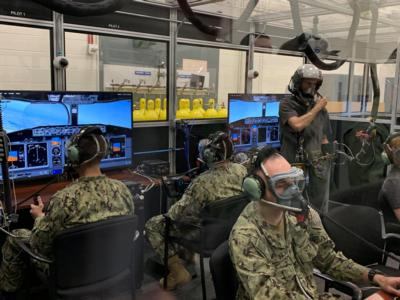Thu, Jun 10, 2021
Former Methods Often Caused Decompression And Barotrauma Sickness
The Naval Aviation Training Systems and Ranges program office (PMA-205) Normobaric Hypoxia Trainer (NHT) team recently designed, delivered, installed, and began support of the NHT at Naval Air Station (NAS) Patuxent River, the first trainer of its kind eliminating common hypoxia training injuries.

The legacy Low Pressure Chamber trainer used in hypoxia training for pilots and aircrew often caused decompression and barotrauma sickness, the leading causal factors for training injuries in the Naval Aviation Survival Training Program (NASTP). The NHT team, made up of an expert group of research engineers and scientists, looking to mitigate those injuries, developed the NHT concept.
“With the critical and innovative work of our NHT team, we no longer need to worry about barotrauma during cold and sinus season that caused trapped gas pain and injury in our fixed wing non-ejection seat aircrew students at the Aviation Survival Training Centers,” said Cmdr. Andy “Lurch” Hayes, NASTP integrated project team lead. “Inside safety observers no longer need to administer nasal decongestants or perform the invasive Politzer maneuver to inflate the middle ear and sinuses by injecting compressed air up one nostril while the other was closed.”
The NHT design not only eliminates the risk of barotrauma and decompression sickness, but it also can simulate high altitude flight while accommodating up to 12 personnel including six aircrew and two pilot/co-pilot teams monitored by two inside observers. Borrowed from the success of students trained on the Reduced Oxygen Breathing Device, the team included flight simulators and controls to add realism and allow aircrew to practice Emergency Procedures (EP) specific to their Naval Air Training and Operating Procedures Standardization aircraft. This is the first time in naval aviation history that fixed wing non-ejection seat pilots are able to practice EPs in a state of hypoxia.
“Gone are the days of patty cake in the chamber to monitor hypoxia symptoms. We are fortunate to have the aviation physiology expertise on our team that creatively developed a training system that allows the aircrew to experience hypoxia in a safe environment while conducting aviation operator tasks,” said Capt. Lisa Sullivan, PMA-205 program manager.
More News
From 2023 (YouTube Version): Legacy of a Titan Robert (Bob) Anderson Hoover was a fighter pilot, test pilot, flight instructor, and air show superstar. More so, Bob Hoover was an i>[...]
Get The Latest in Aviation News NOW on Instagram Are you on Instagram yet? It's been around for a few years, quietly picking up traction mostly thanks to everybody's new obsession >[...]
Aero Linx: B-52H Stratofortress The B-52H Stratofortress is a long-range, heavy bomber that can perform a variety of missions. The bomber is capable of flying at high subsonic spee>[...]
Altimeter Setting The barometric pressure reading used to adjust a pressure altimeter for variations in existing atmospheric pressure or to the standard altimeter setting (29.92).>[...]
"Knowing that we play an active part in bettering people's lives is extremely rewarding. My team and I are very thankful for the opportunity to be here and to help in any way we ca>[...]
 Classic Aero-TV: Remembering Bob Hoover
Classic Aero-TV: Remembering Bob Hoover ANN FAQ: Follow Us On Instagram!
ANN FAQ: Follow Us On Instagram! ANN's Daily Aero-Linx (05.15.24)
ANN's Daily Aero-Linx (05.15.24) ANN's Daily Aero-Term (05.15.24):Altimeter Setting
ANN's Daily Aero-Term (05.15.24):Altimeter Setting Aero-News: Quote of the Day (05.16.24)
Aero-News: Quote of the Day (05.16.24)



